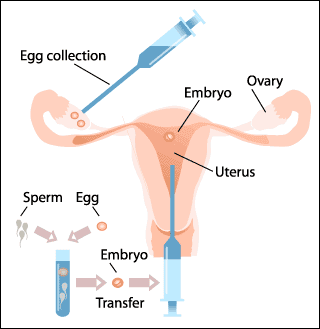
Techniques
In Vitro Fertilization (IVF)
In Vitro Fertilization (IVF) is a form of assisted reproductive technology (ART) used to help a woman become pregnant. It is the process of fertilization by manually combining an egg and sperm in a petri dish in a laboratory.
There are two ways that fertilization can occur:
Conventional Fertilization: Is used when there are blocked fallopian tubes or unexplained infertility. The embryologist isolates the healthy sperm which are then exposed to each egg where fertilization occurs naturally.
Preimplantation Genetic Diagnosis (PGD)
Preimplantation genetic diagnosis (PGD), also known as preimplantation genetic screening (PGS), is a screening test used to determine if genetic or chromosomal disorders are present in embryos produced through in vitro fertilization (IVF). One or two cells are removed from an embryo and checked for genetic and/or choromosomal defects. After it is screened, a doctor is able to tell what physical characteristics that child will have; along with any genetic diseases. Only "clean" embryos that are unaffected by the genetic or chromosomal disorder are introduced to the woman's womb.
Several embryo screening techniques are used to select an embryo created by IVF based on their genetic makeup.
PGD and PGS are the only options available for avoiding a high risk of having a child affected with a genetic disease prior to implantation.
Intracytoplasmic Sperm Injection (ICSI): Is used when the quantity or quality of sperm is poor and therefore unable to effectively penetrate the egg on its own. The embryologist selects a single healthy sperm and injects it directly into the center of each egg.
These embryos are grown to the eight-cell-stage in which one or two cells are removed to check for genetic variations linked to diseases. If the procedure is successful, the process is combined with an embryo transfer, which involves physically placing the fertilized egg(s) in the woman's uterus. Usually, 2-4 embryos are placed in the woman's uterus at one time and each attempt is called a cycle.
"Women who are 35 years of age or older are at increased risk to have a child with a chromosome abnormality. PGS can be used to help reduce the risk for the known genetic or chromosomal disorder in the family. In order to have PGS, a couple must consent to have in-vitro fertilization (IVF). Embryos that test normal will be used for transfer and those that test abnormal will be discarded. It's important to remember that this testing is being done on only one or two cells. The amount of DNA available for testing is very limited and testing for only one type of genetic disorder is possible per embryo."
Because only unaffected embryos are transferred to the uterus, preimplantation genetic testing provides an alternative to current postconception diagnostic procedures, which are followed by the difficult decision of abortion if results are unfavorable.
For couples undergoing IVF, preimplantation genetic diagnosis is recommended when:
-
one or both partners have a history of heritable genetic disorders
-
one or both partners is a carrier of a chromosomal abnormality
-
the mother is of advanced maternal age
-
the mother has a history of recurrent miscarriages
-
several pregnany losses or failed IVF cycles
-
women of advanced maternal age
(Citation 4)




